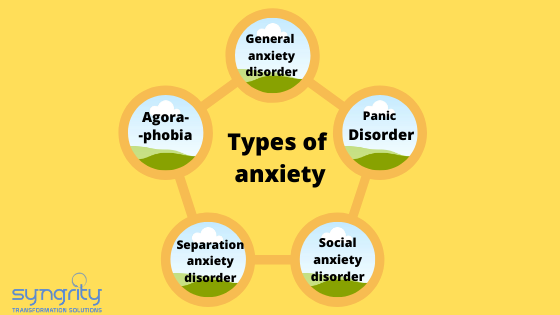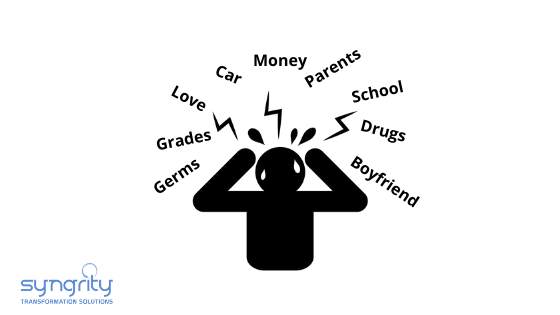As we have tried to comprehend different aspects of stress in our previous blogs written beautifully by Niharika Sharma, which discussed what is stress, what causes stress and how technology has affected the lives of humans by contributing towards the stress. In this blog of our ongoing research work on KOKORO- The Heart of Stillness, we talk about how stress & anxiety can work together hand in hand and disrupt the daily routine of a person.
We all have experienced stress from time to time. But how do we differentiate between positive stress and negative stress? For example, if you have an assignment due and the deadlines are approaching. This can lead to the development of stress, but if this stress makes a person increase his proficiency and output and he/she manages to finish the given assignment before the deadline. The stress is considered to be positive in nature, as no harm was done to the person both mentally and physically. If the stress results in insomnia, poor concentration, distraction, and impairs the person from getting any job done, then the stress is negative in nature, as it has hampered both the mental and physical abilities of that person.
Is anxiety a disorder?
One can say that a normal amount of stress is healthy. When stress becomes disproportionate and starts occurring at a regular interval it can lead to anxiety. In this blog, we will keep our focus towards the first type of Anxiety and will discuss the other types of anxiety one by one in detail in our upcoming blogs.
Generalized Anxiety Disorder (GAD): it has been seen and observed by psychologists that people with Generalized Anxiety Disorder have the tendency to display excessive stress, for most of the days for at least 6 months. This stress can be about personal health, work, social interactions, and everyday routine life circumstances. The fear and anxiety can cause significant problems in areas of life.
Unlike a phobia, where your fear is connected to a specific thing or situation, the anxiety of GAD is diffused—a general feeling of dread or unease that colors your whole life. This anxiety is less intense than a panic attack, but much longer-lasting, making normal life difficult and relaxation impossible. Generalized anxiety disorder is mentally and physically exhausting. It drains your energy, interferes with sleep, and wears your body out.
If you have GAD you may worry about the same things that other people do, but you take these worries to a new level. A co-worker’s careless comment about CAA and NRC, a phone call to a friend that isn’t immediately returned becomes anxiety that the relationship is in trouble. Sometimes just the thought of getting through the day produces anxiety. You go about your activities filled with exaggerated worry and tension, even when there is little or nothing to provoke them.
Signs and symptoms of GAD
Not everyone with a generalized anxiety disorder has the same symptoms, but most people experience a combination of emotional, behavioral, and physical symptoms that often fluctuate, becoming worse at times of stress.
Emotional Symptoms of GAD include:
- Constant worries running through your head
- Feeling like your anxiety is uncontrollable; there is nothing you can do to stop the worrying
- Intrusive thoughts about things that make you anxious; you try to avoid thinking about them, but you can’t
- An inability to tolerate uncertainty; you need to know what’s going to happen in the future
- A pervasive feeling of apprehension or dread
Behavioral symptoms of GAD include:
- Inability to relax, enjoy quiet time, or be by yourself
- Difficulty concentrating or focusing on things
- Putting things off because you feel overwhelmed
- Avoiding situations that make you anxious
Physical symptoms of GAD include:
- Feeling tense; having muscle tightness or body aches
- Having trouble falling asleep or staying asleep because your mind won’t quit
- Feeling edgy, restless, or jumpy
- Stomach problems, nausea, diarrhea
Overcoming Generalized Anxiety Disorder
There are many ways by which a person can deal with Anxiety.
1) Help yourself
In order to do so, there are a few steps that can actually help in overcoming anxiety disorder.
Connect with Others
Support from other people is vital to overcome the effects of anxiety. Social interaction with someone who cares about you is the most effective way to calm your nervous system and diffuse anxiety, so it’s important to find someone you can connect with face to face on a regular basis—your significant other, a family member, or a friend, perhaps.
Build a strong support system
Human beings are social creatures, we are not meant to live in isolation. Few people you can trust and count on to be there for you, creates a very strong support system.
Talk it out when your worries start spiraling
If you start to feel overwhelmed with anxiety, meet with a trusted family member or friend. Just talking face to face about your worries can make them seem less threatening.
Know whom to avoid when you’re feeling anxious
When considering whom to turn to, ask yourself whether you tend to feel better or worse after talking to that person about a problem.
2) Learn to calm down quickly
While socially interacting with another person face-to-face is the quickest way to calm your nervous system, it’s not always realistic to have a friend close by to lean on. In these situations, you can quickly self-soothe and relieve anxiety symptoms by Making use of one or more of your physical senses.
Sight- Look at anything that relaxes you or makes you smile. Like a beautiful view, family photo or your favorite person
Sound– Listen to soothing music, can be live or recorded. Ocean waves, rainfall or wind through trees.
Smell- Light scented candles, smell the flowers in the garden. Smell your favorite perfume.
Taste- Slowly eat a favorite treat, savoring each bite. Herbal tea, coffee, mint or a favorite candy.
Touch- Give your self a hand or neck massage. Cuddle with a pet.
3) Exercise
Exercise is a natural and effective anti-anxiety treatment. It relieves tension, reduces stress hormones, boots feel-good chemicals such as serotonin and endorphins and physically changes the brain in ways that make it less anxiety-prone and more resilient. It can be walking, running swimming, dances, going to a gym.
4) Professional Help
If you’ve given self-help a fair shot, but still can’t seem to shake your worries and fears, it may be time to see a mental health professional. But remember that professional treatment doesn’t replace self-help. In order to control your GAD symptoms, you’ll still want to make lifestyle changes and look at the ways you think about worrying.
Cognitive-behavioral therapy (CBT) is a type of therapy that is particularly helpful in the treatment of GAD. CBT examines distortions in our ways of looking at the world and ourselves. Your therapist will help you identify automatic negative thoughts that contribute to your anxiety.
The five components of CBT for anxiety are:
Education- CBT involves learning about generalized anxiety disorder. It also teaches you how to distinguish between helpful and unhelpful worry.
Monitoring- You learn to monitor your anxiety, including what triggers it, the specific things you worry about, and the severity and length of a particular episode.
Physical control strategies- CBT for GAD trains you in relaxation techniques to help decrease the physical over-arousal of the “fight or flight” response.
Cognitive control strategies- Teach you to realistically evaluate and alter the thinking patterns that contribute to generalized anxiety disorder.
Behavioral strategies- Instead of avoiding situations you fear, CBT teaches you to tackle them head-on. You may start by imagining the thing you’re most afraid of. By focusing on your fears without trying to avoid or escape them, you will feel more in control and less anxious.
Medication for anxiety
Medication for GAD is generally recommended only as a temporary measure to relieve symptoms at the beginning of the treatment process, with therapy as the key to long-term success.
References:
- http://ncrb.gov.in/StatPublications/ADSI/ADSI2016/chapter2%20suicides.pdf
- https://www.researchgate.net/publication/303918537_Academic_Anxiety_among_
Higher_Education_Students_of_India_Causes_and_Preventive_Measures_An_Exploratory_Study - https://www.nytimes.com/2014/12/31/opinion/indias-mental-health-crisis.html
- https://www.nimh.nih.gov/health/topics/anxiety-disorders/index.shtml
- https://thesystemsthinker.com/overcoming-organizational-anxiety/
Vipin Kumar Tanwar is associated with Psycho-social clinical studies from the last six years. He has graduated with a Masters Degree in Clinical Psychology with a keen interest in establishing the Philosophy of relationship between Psychology and our Society. He is now working with Syngrity Transformational Solutions.
“Man knows much more than he understands.” – by Alfred Adler










 MALATI VASUDEVA
MALATI VASUDEVA VIKRAM BADHWAR
VIKRAM BADHWAR PRIYANKA KUMAR
PRIYANKA KUMAR SUMAL VARGHESE
SUMAL VARGHESE















Very detailed and informative piece. Eargerly looking forward to more blogs!
Thank you Niharika
So true !! This is something each of us can relate to …easily. Anxiety is an everyday issue, for sure.
I accidentally reach to your blog but i thought i reach at right place. Your blog is really very good.
Thank you so much, means a lot.